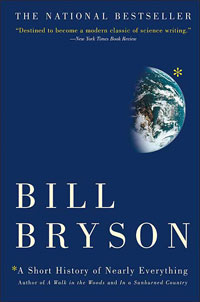Book Notes
 Bill Bryson, A Short History of Nearly Everything (New York: Random House-Broadway Books, 2003), 544pp.
Bill Bryson, A Short History of Nearly Everything (New York: Random House-Broadway Books, 2003), 544pp.
I first read Bill Bryson when a friend recommended that I obtain his book A Walk In the Woods in order to prepare me to hike the 200-mile John Muir Trail. In his Walk Bryson recounts how he and an old friend, both grotesquely out of shape at middle age, hiked the 2,100-mile Appalachian Trail from Georgia to Maine. I am a rookie hiker and my friend advised that Bryson would be an affable if introductory guide. Similarly, you could put my knowledge of science in a thimble (I do remember the bunsen burner from high school), so reading Bryson's popular-level history of science was a perfect fit for me. And for others, too, judging from its success. A Short History spent six months on the bestseller list of the New York Times, which predicted that it is "destined to become a modern classic of science writing."
Bryson disarms readers from the get-go when he explains why he wrote his book. On a long flight across the Pacific ocean he realized "with a certain uncomfortable forcefulness that I didn't know the first thing about the only planet I was ever going to live on. I had no idea, for example, why the oceans were salty but the Great Lakes weren't. Didn't have the faintest idea...And ocean salinity of course represented only the merest sliver of my ignorance." After three years of research, reading, interviews, and asking specialists "a lot of outstandingly dumb questions," he wrote this gem.
Bryson is simply a fantastic writer. His prose sparkles page after page, even if the book is a little long. Peppered throughout his history are salient quotes from the experts. A virus, notes the Nobel laureate Peter Medawar, is simply "a piece of nucleic acid surrounded by bad news." To appreciate the hubris of physics consider the scorn of Ernest Rutherford: "All science is either physics or stamp collecting." Bryson has also mastered the analogy to give us at least a faint idea of the spectacular boundaries of scientific inquiry. "If someone struck a match on the moon," he observes, astronomers could "spot the flare." Humor is always a page or so away, as when the famous German Alexander von Humboldt wrly observed the three stages of scientific discovery: "first, people deny that it is true; then they deny that it is important; finally, they credit the wrong person."
From our cosmological origins in just 1 of 140 billion galaxies, to the subatomic spectacle of quarks and gluons, to life on earth and in the sea, in millennia past and in the present, including air and sea, glaciers and cells, Bryson describes the mystery of our world as scientifically understood. What is the weight, diameter, age, or circumference of the earth, and how do we know? What, really, is at the core of the earth? The deepest point in the ocean? Who invented the periodic table that hung on the wall of my tenth grade chemistry class? What was Einstein's "appalling piece of science" that the great physicist admitted was "the biggest blunder of my life?" What is Heisenberg's Uncertainty Principle and why is it so important? Who discovered plate tectonics? Read Bryson and you will learn what scientists know and how they know it.
You will also learn what scientists do not know, and that turns out to be quite a lot. Conjecture, speculation, extrapolation and outright guesswork play a role. Bryson clearly loves and appreciates science, but he does us the service of not divinizing it. His book includes brilliant insights by science, but also grandiose mistakes, enlightened scholars and eccentric mavericks, plodding experiments and accidental breakthroughs, princely human beings and petty egomaniacs, noble quests and infantile squabbles. The outrageously quixotic is never far from view, either, as with the German chemist Hennig Brand who in the seventeenth century thought he could distill gold from urine. All of which is to say that Bryson humanizes the scientific enterprise, and as a consequence makes it so very easy for us to love its labors.


